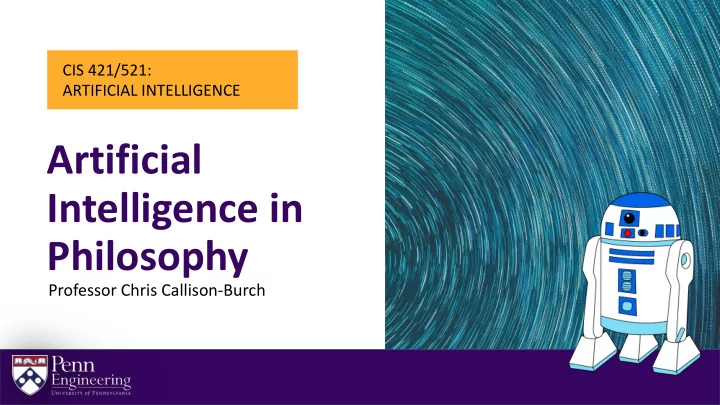

CIS 421/521: ARTIFICIAL INTELLIGENCE Artificial Intelligence in Philosophy Professor Chris Callison-Burch
René Descartes (1596-1650) cogito ergo sum “I think, therefore I am." Principle of dualism – that the mind or thinking self is essentially incorporeal or spiritual – that the mind exists separately from the body: "if a foot or arm or any other part of the body is cut off, nothing has thereby taken away from the mind." CIS 421/521 | Property of Penn Engineering | 2
René Descartes (1596-1650) How can I know that you are not an automaton? Rene Descartes wondered if he could know for sure that others who looked and behaved like him weren’t in fact automata. Bodies of people and animals are nothing more than complex machines - the bones, muscles and organs could be replaced with cogs, pistons and cams. CIS 421/521 | Property of Penn Engineering | 3
17 th and 18 th century automotons CIS 421/521 | Property of Penn Engineering | 4
René Descartes (1596-1650) Let’s design a test that only a person could pass. “if there were machines bearing the image of our bodies, and capable of imitating our actions. For example, if touched in a particular place it may demand what we wish to say to it; if in another it may cry out that it is hurt. However there would be two tests to know that they were not really men.”… They could never use properly use language. CIS 421/521 | Property of Penn Engineering | 5
Alan Turing (1912-1954) Can machines think? Let’s operationalize the question. "I propose to consider the question, 'Can machines think?'" Because "thinking" is difficult to define, Turing chooses to "replace the question by another, which is closely related to it and is expressed in relatively unambiguous words." Turing's new question is: "Are there imaginable digital computers which would do well in the imitation game ?" CIS 421/521 | Property of Penn Engineering | 6
Alan Turing (1912-1954) Can a computer pass as human in a conversation? A human evaluator would judge text-based conversations between a human and a machine designed to generate human-like responses. If the evaluator cannot reliably tell the machine from the human, the machine is said to have passed the test. The test results do not depend on the ability to give correct answers to questions, only how closely one's answers resemble those a human would give. CIS 421/521 | Property of Penn Engineering | 7
Alan Turing (1912-1954) Turing was prosecuted in 1952 for being homosexual. He received chemical castration as an alternative to prison. Turing killed himself in 1954. It wasn’t until the 2000s that Britain finally realized its gross injustice and its complicity in killing someone who should have been treated as a national hero. CIS 421/521 | Property of Penn Engineering | 8
John Searle (1932-) The Chinese Room That’s not thinking. That’s just symbol manipulation. Is the Turing Test a good test of whether machines possess intelligence? No, because the appearance of being a good conversational participant is achievable through simple symbol manipulation. Searle contends that the application of rules to input symbols is not true intelligence. CIS 421/521 | Property of Penn Engineering | 9
CIS 421/521 | Property of Penn Engineering | 10
ELIZA – early NLP computer program CIS 421/521 | Property of Penn Engineering | 11
John Searle (1932-) The Chinese Room Brains cause minds, so computers can’t have minds. Searle contrasts strong AI with weak AI. In strong AI, the computer really is a mind in the sense that it can be literally said to understand and have other cognitive states. In weak AI, computers just simulate thought, their seeming understanding isn't real understanding. He argues that (biological) brains cause minds. CIS 421/521 | Property of Penn Engineering | 12
Daniel Dennett (1942-) Brain in a Vat Where am I if my brain is in a vat instead of my body? Daniel Dennett wrote a short story called “Where Am I?” where he describes being recruited by the Pentagon to have his brain removed from his body and connected via radio links attaching his severed nerves. Body is sent on a secret mission to diffuse bomb without radiation harming brain. CIS 421/521 | Property of Penn Engineering | 13
Daniel Dennett (1942-) Brain in a Vat His body is destroyed by the radiation, but his consciousness continues in the vat. The scientists restore him in a new body. Then it is revealed that constructed a computer duplicate of my brain, reproducing both the complete information-processing structure and the computational speed of my brain in a giant computer program. His brain in a vat is processing symbols. What makes this different than a computer processing symbols? CIS 421/521 | Property of Penn Engineering | 14
Brain in a vat https://www.youtube.com/watch?v= zO0sSJB1TrI
Strong AI versus Weak AI But I will give you extra credit Actually thinking versus merely simulating thinking o if you invent a sentient AI. Are you a brain in a vat? o Would an AI program be equivalent? o We will leave this to the philosophers and instead focus on practical AI programs that work. o CIS 421/521 |16 CIS 550 | Property of Penn Engineering | 16
Machine Learning versus Artificial General Intelligence Within the modern academic AI community, there’s a focus on solving sub-problems that can be benchmarked on leaderboards. There’s a lack of attention to the question of whether it is possible to build systems that are truly intelligent, as we commonly understand intelligence. If you’re interested in philosophical questions about AI, I recommend listening to Lex Fridman’s podcast. CIS 421/521 | Property of Penn Engineering | 17
Recommend
More recommend